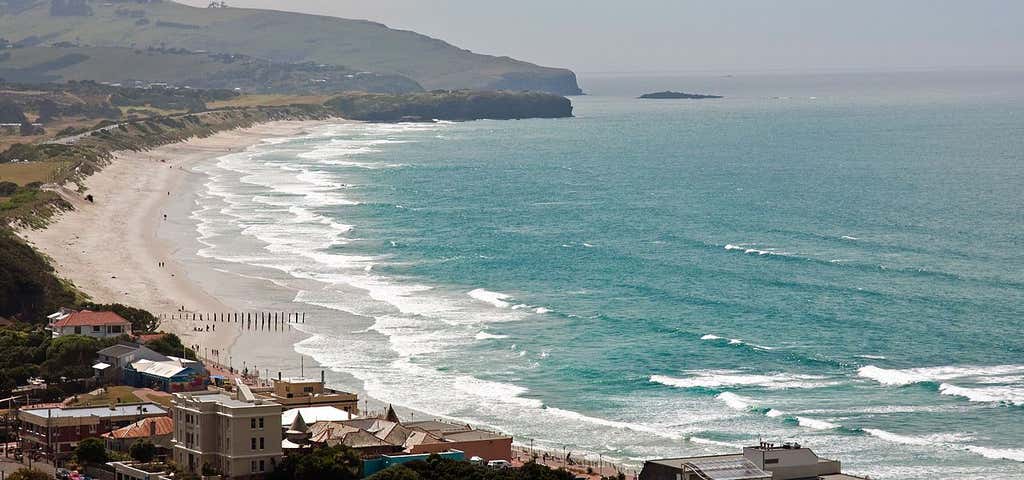The South Island, considered to be Maui’s waka or canoe in Maori legend, is pinched together by a bony, jagged series of peaks and ridges that form the Southern Alps. The Alps run the length of the South Island from the fiords in the southwest to the very top. To the east of this snow-capped icon lies a mosaic of foothills, rolling countryside and patchwork plains that spill out into the South Pacific Ocean creating some unbelievable line-ups, point breaks and wild beaches. In this part of the world the swell tap has been left on full, the locals are mostly friendly and the line-ups are lorded over by 400kg-plus sea lions. But you’ll need a 4/3 steamer in summer. And booties, hood, gloves and a steely commitment in winter as it gets seriously cold!
Tauranga Bay
To the west of Westport and just south of Cape Foulwind, you’ll find Tauranga Bay – one of Westport’s most consistent and picturesque beaches with a left point break. The beach features sand over rock forming a predominantly left hand peak, but sometimes the sand movement opens the right up more. It’s a popular spot with tourists thanks to the nearby seal colony, but the wave can also get very busy. Locals here have a short fuse, so play nicely. And make sure to say hello to Puke – he’s a local legend and runs the West Coast Surf School. In town you’ll find the Tiphead to the east of the Buller River. Tiphead holds a nice punchy wave. And if you strike a north swell don’t overlook the novelty of surfing the freshwater inside the Buller River mouth – because Shingles is a board breaker on its day.
Mangamaunu
Despite taking the full brunt of a 7.8 magnitude earthquake on November 14, 2016, which saw parts of Kaikoura’s coastline thrust upwards by as much as 2m, the iconic arcing right hand walls of Mangamaunu survived. Some even say the quake improved the link from Outsides to Middles. With the optimum swell window coming from the north east to south east quarter, Mangamaunu offers long 200m-plus rides with sections for barrels, big open face turns and racy sections as the wave crosses the boulder-strewn point to Insides and the kick-out spot on the beach. With the bay encircled by snow-capped mountains, getting this spot on will have you fizzing for a lifetime. Catch sight of a whale while in town and you’ll fall in love with Kaikoura forever.
Cobden Greymouth
The mouth of the Grey River is eased out into the Tasman Sea by two break walls and the northernmost break wall creates a booming peak with lefts and rights on offer in the big southwest to west swells that frequent this coastline. It’s a hunting ground for tuberiders and can handle plenty of size. If it’s really big then paddling off the beach is near impossible, so jump off the side of the break wall if you back yourself. Cobden beach stretches north and has nice little peaks if you strike an easterly, which is offshore. In a big northwest swell, which are often generated during summer months when the tropical cyclones pass across the top of New Zealand and near shore storm systems develop on the east coast of Australia, you’ll get the chance to surf the opposite side of the break wall. Known as Blaketown, the peak nearest the wall can produce some of the best rights on the coast. And when Cobden is truly maxing you may find Wavetraps, on the inside of the break wall, producing fast, hollow rights.
Taylors Mistake
While it may have been a mistake when first mate Mr Taylor took over the helm of the Gwalior in 1853 (after the captain threw himself overboard), and mistook the bay for the entrance to Lyttelton Harbour, Taylor’s Mistake is the gem of Christchurch surfing. Stumble across it with a north east swell and southerly winds and you’ll find out what all the fuss is about. The beach has lefts and rights that shift with the swell angle and it can get super hollow. And if you’re feeling adventurous then the Akaroa Peninsula, directly opposite Godley Head, harbours some remote beaches and promising aspects.
St. Clair Beach
Located just 10-minutes’ drive from the Octagon in the centre of Dunedin City, St Clair Beach is the beating heart of southern surfing. It features a right-hand point break and several other quality beach and sand-over- reef breaks that help spread the crowds. The whole arena is bordered by an Aussie-esque heated saltwater pool, and strip of cafes, restaurants, bars and hotels dotted along the St Clair Esplanade. The point on its day offers a long right that can break from way out the back all the way to the surf lifesaving club near the infamous St Clair Poles. You’ll need a solid south swell and a light north westerly to score it in its prime. Don’t underestimate Kiddies Corner, the left on the beach in the crook of the esplanade, or any of the peaks that litter the 3km stretch to Lawyers Head. If the crowds are doing your head in then just search a little bit further and you’ll be sure to find a gem all to yourself.
Karitane Bar
Located at the tidal mouth of the Waikouaiti River in the small, sleepy fishing village of Karitane, you’ll find this rippable right hand sand-bottomed point break. The wave starts on the rivermouth shoal before arcing into the bay in long peeling lines that can range from solid and intense to soft and playful as the swell shifts through its narrow window. Any swell from the northeast to east will get in here and any big southeast swell will find its way, too. Look for any wind from the west to south Quadrant, because the bigger it gets the better this place breaks. (Sadly those very big days are rare.) The paddle back out can be a long one, so locals usually shoot across the sand isthmus and float back out the rivermouth. And if you have the skill, then look beyond the bar take-off and you’ll find a kelp-cloaked reef that can handle the very biggest of swells.
Aramoana Beach
Dunedin is one of the great surf cities of the world with two coasts making sure there is a quality wave within 40-minutes’ drive of the city all year round. Aramoana is arguably the best beach on the north coast. Located adjacent to the Otago Harbour mouth, the tidal currents and dredging create an offshore shoal that directs swell energy, focusing it directly on its target: the peaks scattered along Aramoana’s beaches. Take your pick from the smaller south east corner to the First, Second and Third Rock peaks that seem to grow as you head toward the northwest end. Any swell from the north or a large east swell (or very large southeast swell) will get in here and it is offshore in a south west. Keep an eye out for sea lions and watch the rare yellow-eyed penguins running the gauntlet on the beach at dawn and dusk.
Allan's Beach
Dubbed the wildlife capital of New Zealand for its rare and endangered seabird and marine mammal populations, the Otago Peninsula is as beautiful as it is wild. The many quality surf beaches on the peninsula are fuelled directly from the Southern Ocean storms that wash up the edge of New Zealand. Allan’s Beach is one of the all-time favourites, for its consistency and quality. The white-sand beach is offshore in a northwest with the southern corner handling any wind clocking around to the southwest. It can get very big here, with the Hoopers Inlet mouth producing the best banks when the swell is maxing. On smaller days, you can usually find your own peak directly in front of the carpark, which is behind the dunes in a stand of old man pines on the north side of the inlet. There are plenty of sea lions here and they like to herd the humans out of the water, so take care.
Curio Bay and Porpoise Bay
The 100km of coastline that stretches from the Clutha Rivermouth in the north to the Mataura Rivermouth in the south is known as the Catlins – a forgotten wilderness that is brimming with adventure and secret surf spots. Near the southern end, you’ll find the sheltered arc of Curio Bay that holds everything from small playful waves in the calmer southern end to board-breaking barrels in the other. Just pick your comfort zone along the 2.8km curve of beach and paddle out. There are big wave spots nearby, but these are reserved for the most experienced surfers only. This spot is also known as Porpoise Bay and if you’re lucky you’ll discover why: pods of endangered Hector’s dolphins frequent the bay and love to interact with swimmers and surfers. Just remember - please keep 50 metres away from these little guys and please, DO NOT touch the friendly little dolphins. Touching their delicate skin can injure them and with their tiny numbers this is the last thing they need. (There are sign boards on the beach detailing guidelines for swimming around them, so please take note of these.)
Riverton Rocks
Riverton is a sleepy fishing village to the west of Invercargill and it’s the gateway to the waves on the southwestern corner of the South Island. The town transforms into one of New Zealand’s most amazing surf spectacles on a large south or southeast swell that turns the stretch of coast known as Riverton Rocks into a very long - Kilometre-plus - right hand sandy point break. We’re talking serious jelly legs here. It can peel from a foot to around four foot if you’re very lucky. Few get it on, but those who do speak about it with eyes wide. In smaller swells try Colac Bay, Nick’s Point or Porridge. If you have a nose for adventure that is.
Explore More Trip Guides
Top Surf Breaks - North Island
- 10 Places
Route 66 Leg 2: St. Louis to Tulsa
- 61 Places
- 18:31
- 876 mi












